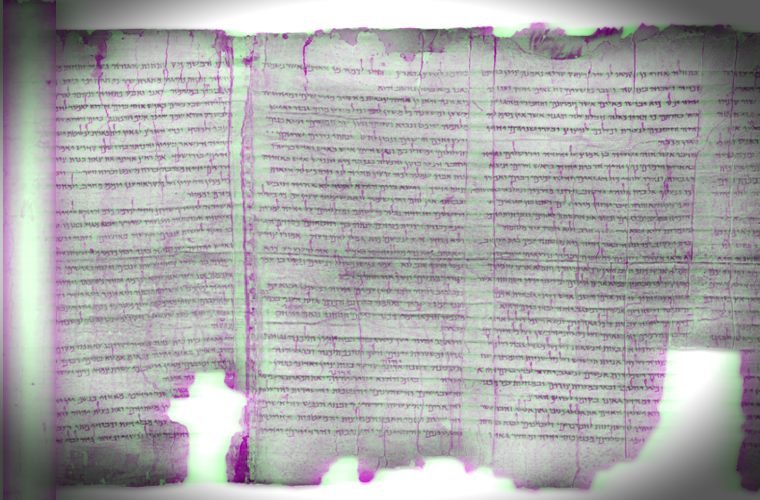While few artifacts are as famous as the Dead Sea Scrolls, the actual identities of the people who penned the oldest known copies of the Bible, specifically the Old Testament, have remained a mystery since they were first discovered in 1900.
Now, a group of researchers from the University of Groningen have used Artificial Intelligence to answer some of the oldest questions about those authors, including whether or not a single person wrote the most controversial of those scrolls.
“Demonstrating that two main scribes, each showing different writing patterns, were responsible for the Great Isaiah Scroll,” the published paper states, “this study sheds new light on the Bible’s ancient scribal culture by providing new, tangible evidence that ancient biblical texts were not copied by a single scribe only but that multiple scribes, while carefully mirroring another scribe’s writing style, could closely collaborate on one particular manuscript.”
Background: Who Wrote The Dead Sea Scrolls?
Presented in the April 21st edition of the journal PLOS ONE, the research team led by Mladen Popovic, Groningen’s Biblical studies professor at the Faculty of Theology and Religious Studies, outlines the approach he and his team used to determine how they solved some of these mysteries.
For instance, was the traditional method of ascribing singular authorship of a particular scroll based on simple writing style accurate, or is there a better way to know if a specific scroll was written by more than one author?
“They would try to find a ‘smoking gun’ in the handwriting, for example,” Popovic explained of scholars who used this traditional method in the press release announcing the results, “a very specific trait in a letter which would identify a scribe.”
However, as the head of the Qumran Institute, which is dedicated to studying the Dead Sea Scrolls, professor Popovic points out that this classical approach has led to a lot of dubious results, including some that remain hotly debated. And it was this problem, along with the professor’s proposed solution, that led to the European Research Council to fund his ‘The Hands That Wrote the Bible’ initiative.


Analysis: How can AI Help Us Decode The Dead Sea Scrolls?
To accomplish his potentially history-making goals, the professor knew he would need help, so he reached out to his colleague Lambert Schoemaker, a Computer Science and Artificial Intelligence professor in the University’s Faculty of Science and Engineering, and asked him to join the effort.
According to the release, Schoemaker himself had already spent years working on methods for computers to read human handwriting, especially from historical documents, and “has also performed studies to investigate how biomechanical traits, like how someone holds a pen or stylus, would affect handwriting.”
Popovic rounded out the team with Ph.D. candidate Maruf Dhali before the group zeroed in on one particularly notable and controversial scroll known as Qumran Cave Scroll 1 (1Qlsa) or the “The Great Isaiah Scroll.”
To the human eye, the Great Isaiah Scroll’s handwriting seems so uniform that some scholars think it was written by one author. Others, however, suggest it may have been written by two scribes with similar writing styles, so the team thought it seemed like an ideal candidate for their approach.
“This scroll contains the letter aleph, or “a”, at least five thousand times,” says Schomaker. “It is impossible to compare them all just by eye.”
However, computers are ideal for such a task, and using detailed digital imaging of the original texts makes analyzing the scrolls at the micro-level possible. This, the study noted, includes measuring a portion of the writing’s curvature (textural) or even the shape of entire characters (allographic).


Of course, Popovic admits that these are the same things that scholars take into account already when trying to decipher who wrote which scroll, but not at the micro-level, and most assuredly on the massive scale that artificial intelligence can.
“The human eye is amazing and presumably takes these levels into account too,” Popovic says. “This allows experts to ‘see’ the hands of different authors. But that decision is often not reached by a transparent process, [and] it is virtually impossible for these experts to process the large amounts of data the scrolls provide.”
To allow the computers to do their magic, Dhali developed what the paper describes as a “state-of-the-art neural network” and then trained his AI using deep learning so it can separate the handwritten text from the background document. This separation, or “binarization” process, allowed the team to keep the original traces of the ancient ink made over two millennia ago completely intact.
“This is important,” explained Schomaker, “because the ancient ink traces relate directly to a person’s muscle movement and are person-specific.”
When Dhali applied this technique to the infamous Great Isaiah Scroll, his analysis of the different features showed that the 54 columns of text indeed fell into two distinct groups and not one. To determine if this difference was because there was more than one writer, Schomaker ran his own comparisons. The results were the same, seemingly indicating two different authors for this scroll rather than one.
To put their results through one final visual check to make sure their mathematical results were borne out through a traditional visual inspection, the team created what they called a ‘heat map’ that incorporated all of the variants of any given character from across the entire scroll. Using this heat map, they produced an average version of each character from the first 27 columns and an average character for the second 27. And, as the first two rounds of tests indicated, that is when they knew their result was correct.
“Comparing these two average letters by eye,” the study concludes, “shows that they are different.”
Outlook: The Mystery May Soon Be Solved
As for the overall significance of their findings, Popovic notes that not only did they prove the dual authorship of the Great Isaiah Scroll, but they may have accomplished something even more significant and personal in the process.
“We are now able to identify different scribes,” he says. “We will never know their names. But after seventy years of study, this feels as if we can finally shake hands with them through their handwriting.”
When describing what happens next, Popovic said he believes that his team’s process can offer researchers an entirely new tool when trying to understand the people who wrote these sacred texts so many years ago.
“This opens a new window on the ancient world that can reveal much more intricate connections between the scribes that produced the scrolls. In this study, we found evidence for a very similar writing style shared by the two Great Isaiah Scroll scribes, which suggests a common training or origin. Our next step is to investigate other scrolls, where we may find different origins or training for the scribes.”
Follow and connect with author Christopher Plain on Twitter: @plain_fiction
Don’t forget to follow us on Twitter, Facebook, and Instagram, to weigh in and share your thoughts. You can also get all the latest news and exciting feature content from The Debrief on Flipboard, and Pinterest. And subscribe to The Debrief YouTube Channel to check out all of The Debrief’s exciting original shows: The Official Debrief Podcast with Michael Mataluni– DEBRIEFED: Digging Deeper with Cristina Gomez –Rebelliously Curious with Chrissy Newton

